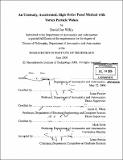| dc.contributor.advisor | Jaime Peraire and Jacob K. White. | en_US |
| dc.contributor.author | Willis, David Joe, 1978- | en_US |
| dc.contributor.other | Massachusetts Institute of Technology. Dept. of Aeronautics and Astronautics. | en_US |
| dc.date.accessioned | 2008-01-10T17:29:49Z | |
| dc.date.available | 2008-01-10T17:29:49Z | |
| dc.date.copyright | 2006 | en_US |
| dc.date.issued | 2006 | en_US |
| dc.identifier.uri | http://dspace.mit.edu/handle/1721.1/35592 | en_US |
| dc.identifier.uri | http://hdl.handle.net/1721.1/35592 | |
| dc.description | Thesis (Ph. D.)--Massachusetts Institute of Technology, Dept. of Aeronautics and Astronautics, 2006. | en_US |
| dc.description | Includes bibliographical references (leaves 125-138). | en_US |
| dc.description.abstract | Potential flow solvers for three dimensional aerodynamic analysis are commonly used in industrial applications. The limitation on the number of discretization elements and the user expertise and effort required to specify the wake location are two significant drawbacks preventing the even more widespread use of these codes. These drawbacks are addressed by the hands off, accelerated, unsteady, panel method with vortex particle wakes which is described. In the thesis, an unsteady vortex particle representation of the domain vorticity is coupled to several boundary element method potential flow formulations. Source-doublet, doublet-Neumann membrane (doublet lattice), and source-Neumann boundary integral equation formulations are implemented. A precorrected-FFT accelerated Krylov subspace iterative solution technique is implemented to efficiently solve the boundary element method linear system of equations. Similarly, a Fast Multipole Tree algorithm is used to accelerate the vortex particle interactions. Additional simplification of the panel method setup is achieved through the introduction of a body piercing wake discretization for lifting bodies with thickness. | en_US |
| dc.description.abstract | (cont.) Linear basis functions on flat panel surface triangulations are implemented in the accelerated potential flow framework. The advantages of linear order basis functions outweigh the increased complexity of the implementation when compared with traditional constant collocation approaches. Panel integration approaches for the curved panel, double layer self term are presented. A quadratic curved panel, quadratic basis function, Green's theorem direct potential flow solver is presented. | en_US |
| dc.description.statementofresponsibility | by David Joe Willis. | en_US |
| dc.format.extent | 138 leaves | en_US |
| dc.language.iso | eng | en_US |
| dc.publisher | Massachusetts Institute of Technology | en_US |
| dc.rights | M.I.T. theses are protected by copyright. They may be viewed from this source for any purpose, but reproduction or distribution in any format is prohibited without written permission. See provided URL for inquiries about permission. | en_US |
| dc.rights.uri | http://dspace.mit.edu/handle/1721.1/35592 | en_US |
| dc.rights.uri | http://dspace.mit.edu/handle/1721.1/7582 | |
| dc.subject | Aeronautics and Astronautics. | en_US |
| dc.title | An unsteady, accelerated, high order panel method with vortex particle wakes | en_US |
| dc.type | Thesis | en_US |
| dc.description.degree | Ph.D. | en_US |
| dc.contributor.department | Massachusetts Institute of Technology. Department of Aeronautics and Astronautics | |
| dc.identifier.oclc | 74900794 | en_US |
